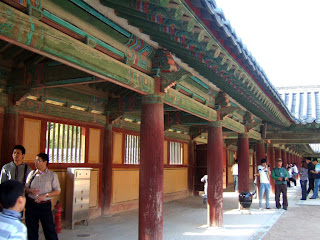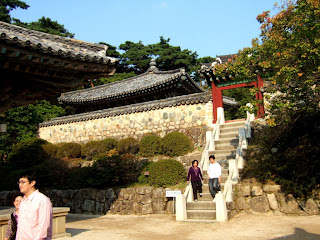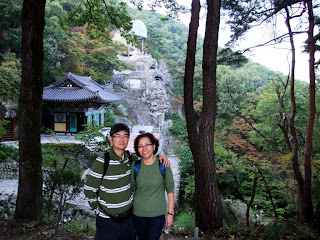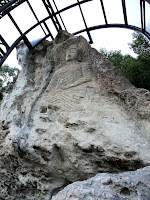
Bulguksa and Seokgaram Grotto situated at the slopes of Mt Toham in Gyeongju City, is a religious architectural complex of exceptional significance in Korea. The 3.8 meter high granite Buddha at Grotto and 38 reliefs of Bodhisattva, Gods and Buddha's disciples along the grotto walls were of 1200 years in history. Bulguksa houses seven national treasures in the country. The entire site was added to UNESCO world heritage sites in 1995. Bulguksa, a master piece of golden age of Buddhist Art in Silla Kingdom, is Temple of The Buddha Land.


Seokguram Grotto and Bulguksa were built by Prime Minister Kim Dae-seong during the reign of King Gyeongdeok in year 751 in memory of his parents of the former life and parents of his current life. Temple complex begun by Kim Dae-seong and restored in 1973 to its former splendor. There were 80 buildings in the complex but many were destroyed during war period. The wooden hall was totally burnt down during Japanese invasion in 1592. Buildings nested in a grove of twisted pines for accommodation of 100 over resident monks were merely restored structures.



The beautiful Koi garden behind the main entrance gate.









The two treasures Seokgatap and Dabotap pagodas stands in the main compound. Most of the halls are with green, red and gold painted eaves, beams, and ceilings named as Tanclang in Korea.


Seokgatap, the 3-storey Buddha Sakhamuni Pagoda, has a height of 8.2 meter with simple lines and minimal detailing of Korean's tradition. It was constructed over 13 centuries. Dabotap with a height of 10.4 meter is well known for its highly ornate structures that are dedicating to many treasures Buddha mentioned in Lotus Sutra. Korean's 10 won coin has a reproduction of its picture.



A version of Dharani Sutra dated between 704-751 AD printed on a 8x63cm mulberry paper scroll found in 1966, was enshrined in Bulguksa. It was an earliest woodblock print in the world.


The Temple complex was centered around two courts, one of which is on Gwaneumjeon where the image of Boddhisattva Guan Yin is offered. Boddhisattva of Great Compassion stands at the highest point of the complex.


Below Halls of Boddhisattva Guan Yin is Vairocana Buddha Hall which houses a national treasure, a gilt bronze Buddha of Enlightenment.


The steep stone stairway up to Gwaneumjeon


The hall of great enlightenment, Daeungjeon is at the main court. It enshrines the image of Sakyamuni Buddha. The building was constructed in year 681.



Korean's traditional art of painting beams, eaves and ceiling and the wood floor inside the main shrine.




Stand near the main compound is Geuknakjeon hall that house the gilt bronze of a seated Amitabha Buddha, which is also another treasure of the country.



The drum house and the spacing corridor that splits the two courts of buildings.


There is a double sectioned staircase and bridge leading to the inside compound of Temple Sokgyemun at the entrance. The lower part of stairway is 6.3 meter with 17 steps and upper portion is 5.4m with 16 steps. The 33 steps high corresponding to 33 steps to enlightenment. To avoid the prints on the stairway faded away, visitors are prohibited to walk through it.


At the foreground are two bridges namely Blue Cloud and White Cloud Bridge while at the back are the Lotus Flower and Seven Treasure Bridges. Both bridges share the 45 degree incline arch underneath.


The clear holy water from mountain height, received in a pond near Sokgyemun Temple site, was really very refreshing and sweet in taste.



The information center and little souvenir stores right at front site of Bulguksa, were solely built from wood, its so cut and pretty.


Huge area of rice farm appeared in golden hue color along the way towards south of Gyeongju to Bulguksa



 Another Temple we visited was Golgulsa, 20 km east of Gyeongju. Golgulsa which means Stone Buddha Temple literally, is the only cave temple in Korea. The original Temple was built out of solid rock with a sculpture of Maya Tathagata Buddha, during 6th century by Saint Kwang Yoo and a Buddhist monk from India.
Another Temple we visited was Golgulsa, 20 km east of Gyeongju. Golgulsa which means Stone Buddha Temple literally, is the only cave temple in Korea. The original Temple was built out of solid rock with a sculpture of Maya Tathagata Buddha, during 6th century by Saint Kwang Yoo and a Buddhist monk from India.


The seated Buddha image was carved on a granite rock surface of Golgulam cliff. Golgulam Hermitage occupied almost half of the mountain, consisting of several temples, training halls, dormitories and dining area. It has the oldest Buddhist ruins on the mountain.



Some of the temples in the cave. The one with red lanterns offered with a stone image of Boddhisattva of Great Compassion, Guan Yin.




Golgulsa is very popular for its Sunmudo Training which include meditation, yoga-like exercises, martial arts and gymnastics. The goal of this training method is to gain the harmonization of mind and body to be united with breathing.



The temple runs Sunmudo Programme since 1992 and opens for temple stay for foreigners who are interested in traditional Korean Seon (Zen) Buddhism. Their program includes "still" training in the morning and "active" practices in evening time, chargeable at about US$50.00 per person.



It was a tough way to climb up to the cave and pray to the Stone Buddha but we managed to make it.





We enjoyed a local traditional meal for our dinner after a whole day of temple visit. Restaurant Sampoo was strongly recommended by our driver and it indeed was very wonderful. For a table of main and side dishes, we paid US$9.00 per person.


No comments:
Post a Comment